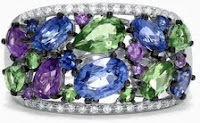Let's say you'd love to own jewelry with big diamonds but can't afford the bigger sizes without mortgaging your home or selling your children. Diamond prices increase exponentially per carat as you move up in carat weight because big eye-clean diamonds are rare in nature.
The answers are: Be flexible on color and clarity to buy a bigger stone.
Next, let's discuss clarity: When it comes to flaws, diamonds have 2 types: blemishes (surface flaws) and inclusions (internal flaws). All-natural diamonds have inclusions or defects. Under a microscope, jewelers see "feathers, bruises, indented naturals and chips, etched channels, and cavities" that can't be seen with the naked eye. In fact, clarity is considered the least important characteristic in a diamond, and where you can compromise the most to get a bigger diamond as long as you examine the stone carefully to make sure the inclusions are hidden and not prominent. Experts usually recommend settling on a diamond with VS2 (Very Slight 2) in clarity to get "the most bang for the buck." A diamond with inclusions can still look eye-clean.
The cons are: I3 diamonds usually have too many inclusions that affect a diamond's brilliance and beauty. According to Teach Jewelry, ''The difference between I3 and I1 and I2 clarity diamonds is the number, type, position, and size of inclusions." No matter the angle, the inclusions, or imperfections will likely diminish the stones' sparkle (the ability of a diamond to collect and reflect light). How disappointing to spend $5,400+ for diamonds "with large, dark, and easily seen inclusions" that limit their brilliance. Dull diamonds are not what one pays for -- I'd miss the glitter, the sparkle, the shine ... as well as the money leaving my bank account.😳
 |
| I3 diamonds are called salt and pepper diamonds due to the black spots they often have. These inclusions are too noticeably to be eye-clean. |
A few sources cite if inclusions are on the edge of a diamond, your diamond could break off and an I3 diamond is harder to resale, but I dismiss these 2 reasons for avoiding it. Jewelry is always a luxury buy. All jewelry is a poor investment as you'll rarely get the price you paid if reselling it. If you do pay less for less quality, getting some of your money back by reselling it is a fair trade-off. And on Moh's Hardness Scale, diamonds are a 10, the hardest gems you can buy. Stones in earrings are unlikely to break with normal wear. Not to mention, you should remove rings to clean your house.
Frankly, diamonds are common in nature, and it's mostly demand that creates their high value. Readers, you are not alone in coveting big-sized diamonds! I, too, am tempted sometimes all the time. An I diamond is fine, but diamond experts tend to advise against buying I3 diamonds for jewelry. It looks like I'll never own a pair of 4-carat diamond studs.💎


















































